2020 Corvette: #20-NA-061: 2020 Chevrolet Corvette New Model Features
Estimated Reading Time: 41 Minutes#20-NA-061: 2020 Chevrolet Corvette New Model Features - (Mar 6, 2020)
Subject: 2020 Chevrolet Corvette New Model Features
|
Brand: |
Model: |
Model Year: |
VIN: |
Engine: |
Transmission: | ||
|---|---|---|---|---|---|---|---|
|
From: |
To: |
From: |
To: | ||||
|
Chevrolet |
Corvette |
2020 |
— |
6.2L Small Block V8 (RPO LT2) |
Tremec Dual Clutch 8 Speed Automatic (RPO M1L) |
||
|
Involved Countries and Regions |
North America and Saudi Arabia |
-
Overview

2020 Chevrolet Corvette
Bulletin Purpose
The purpose of this bulletin is to introduce the 2020 Chevrolet Corvette. The bulletin will provide an overview to help the Service Department Personnel become familiar with the engine, transmission, brake system and some of the other vehicle systems.
Overview
With its new mid-engine configuration and sleek, modern design, the 2020 Chevrolet Corvette Stingray offers unprecedented performance. The mid-engine 2020 Corvette Stingray is the fastest and most powerful entry level Corvette ever produced. Rear weight bias enhances performance in a straight line and on the track, resulting in increased vehicle responsiveness and a sense of control.
-
PDI Special Instructions
-
Note: The hood is not heavy enough to latch under its own weight when closing the panel. Firmly press down on the front edge of the hood until the latch clicks twice. The hood will remain open until the striker is pushed into the latch. Ensure the hood is fully latched before taking the vehicle out of P (Park).
RPO (Regular Production Option) ground effects will be shipped in the front and rear trunks. The panels are for the front underbody close out panels. Z51 equipped vehicles also receive a three-piece front splitter and brake cooling kit.
Important: The rear control arm brake cooling ducts are for track use only. Damage to the ducts may occur if the ducts are left on the vehicle while driving on the street.
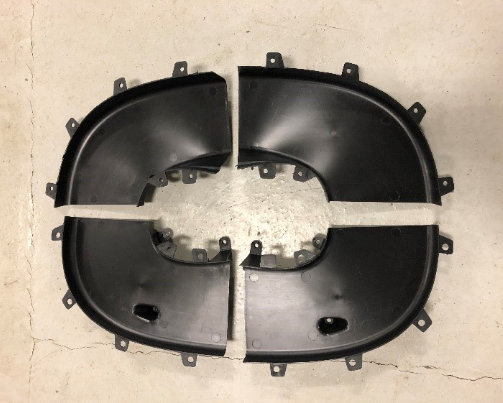
Track Only Rear Lower Control Arm Ducts
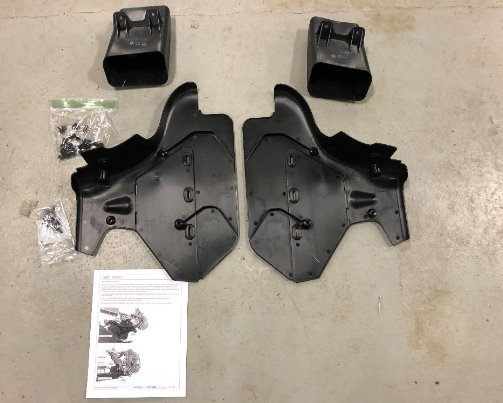
PDI Installed Brake Deflectors Parts
LPO (Limited Production Option) Accessory ground effects will be delivered via local ADIs. In Canada, LPO accessories will be shipped direct to the dealer.
The Navigation system’s SD card (if equipped) is loaded in center console SD card slot. Please do not misplace or exchange the card with other vehicles.
-
Manual Process for Opening Hood, Driver Door, and Rear Hatch
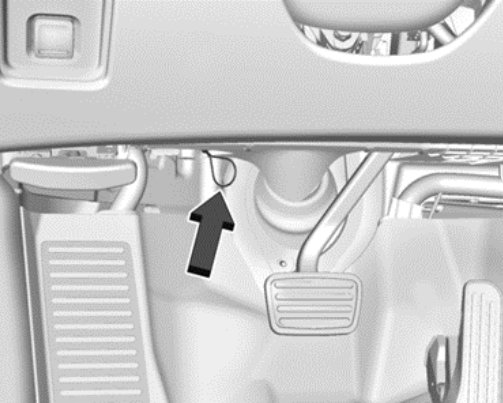
The front hood can be opened manually if the battery should go low by pulling the gray release cable shown above.
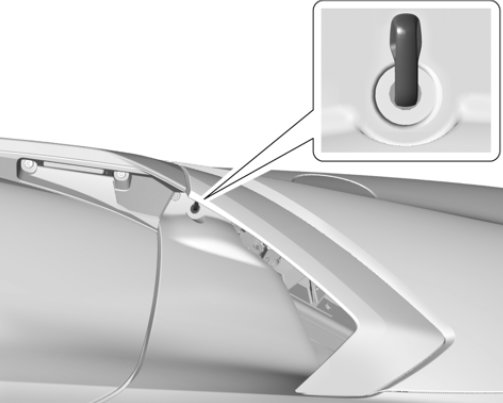
To open the driver’s door, use the key located in the key fob. Insert and turn the key.
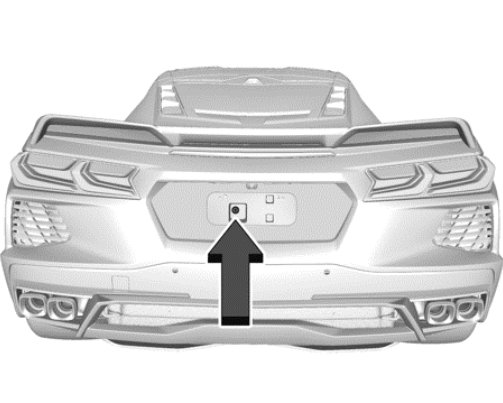
Use the mechanical key in the backup key cylinder behind the license plate to manually open the hatch/trunk.
Note: The license plate must be removed for access.
-
Brakes
-
Overview
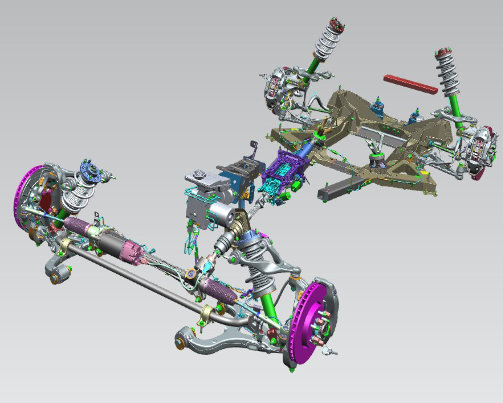
The 2020 Chevrolet Corvette Stingray features two brake options.
RPO JL9 is the base brakes. This system offers all-aluminum four-piston calipers with 321 mm (12.6 in) ventilated FNC rotors in the front and 339 mm (13.3 in) ventilated FNC rotors in the rear. This system also includes non-asbestos-organic brake pads and one-piece cast aluminum or monoblock calipers in the rear.
The up level RPO J55 brake system is standard on all Z51 models. The brake system use non-FNC rotors. Front and rear monoblock four-piston calipers with low metallic brake pads. The ventilated brake rotor in the front are 345 mm (13.6 in) and the rear rotors are 350 mm (13.8 in).
Important: The rear brake J55 brake rotors should not be machined. This is due to the coating at the bottom edge of the rotor’s braking surface will be removed during the machining procedure. This may lead to surface corrosion.
Both brake systems utilize an electronic parking brake system. The parking brake calipers are coated black and are not painted the same color as the brake calipers.
Critical Brake System Service Step
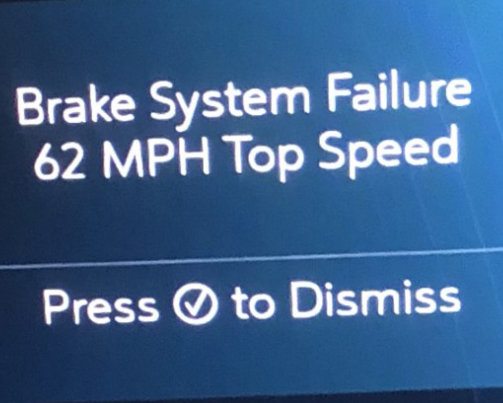
When servicing Electromechanical Brake Booster equipped vehicles, the battery must be disconnected to prevent the brake master cylinder from pressurizing the hydraulic system during its automated self-diagnostic tests that can possibly occur when a door is opened, or the key transmitter is activated. Failure to follow this precaution may cause personal injury. The following DIC message will also be displayed if the battery is not disconnected prior to brake service "Brake System Failure, 62 mph Top Speed" (or metric equivalent, 100 km/h).
Electromechanical Brake Booster
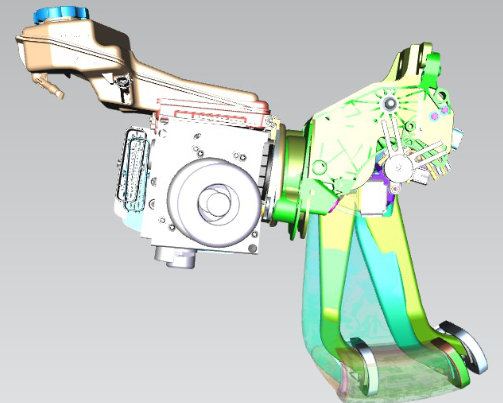
The brake booster unit is designed to operate together with an electronic brake control module that is normally responsible for the ABS, traction control, and stability control. The master cylinder and brake booster unit consist of a master cylinder reservoir, an electronic brake system control module, pedal coupling unit/pushrod, and the brake master cylinder with integrated brake pressure modulator valve.
The brake system control module interprets and converts driver input and then provides a corresponding hydraulic pressure output to activate the brake system according to the driver’s demand.
Driver input force is multiplied by the brake pedal and transferred by the pedal pushrod to the hydraulic brake master cylinder. In an event of no electrical energy or a failure condition, the driver’s input is mechanically converted to a hydraulic pressure output.
Brake Fade Warning Assist
Note: The Brake Fade Warning Assist system is designed for use with the factory-installed brake pads or GM-approved replacement pads. If the brake pads on the vehicle need to be replaced, use GM-approved brake pads. If this is not done, the brake fade warning system may not function properly.
The Brake Fade Warning Assist system monitors the performance of the brake system. If the system detects brake fade, or if the brake fluid is near the boiling point, the driver will be alerted.
Stage 1 - The Driver Information Center (DIC) displays a "Reduce Braking to Avoid Overheating" message and brake pedal effort and travel is increased. When the message displays, the driver should decrease brake pedal pressure.
Stage 2 - The Driver Information Center (DIC) displays a "Brakes Overheated Service Now" message that the brake fluid temperature is excessive and is about to boil. The system increases brake pedal effort and travel and will also limit vehicle speed. The driver should immediately start a cool down lap if on the track. If this message displays, take the vehicle to be serviced at your dealer.
Multifunction Switch
Pressing the traction control switch manually disables or enables the traction control and stability control. The BCM monitors the signal circuit from the traction control switch. When the traction control switch is pressed, the BCM sends a high speed serial data message to the brake system control module, indicating the switch position.
Multi-Axis Acceleration Sensor
The multi-axis acceleration sensor includes the yaw rate, lateral acceleration, and longitudinal acceleration sensors and is internal to the inflatable restraint sensing and diagnostic module. The brake system control module receives serial data message inputs from the yaw rate, lateral acceleration, and longitudinal acceleration sensors. The module activates stability control and the hill hold/hill start assist function, depending on multi-axis acceleration sensor input.
Power-Up Self-Test
A power-up self-test is performed to verify correct operation of system components. This phase consists of internal self-testing along with electrical checks of system sensors and circuits when the key is on. During this phase, the brake system control module is able to detect many system malfunctions. However, certain failures cannot be detected unless active diagnostic tests are performed on the components. Shorted solenoid coils or motor windings, for example, cannot be detected until the components are commanded on by the brake system control module.
Important: The battery must be disconnected to prevent the brake master cylinder from pressurizing the hydraulic system during its automated self-diagnostic tests that can possibly occur when a door is opened, or the key transmitter is activated. Failure to follow this precaution may cause personal injury. This needs to be done whenever servicing the brake components. This includes brake pads or rotor replacements. Failure to disconnect the negative battery will also lead to a DIC message that reads "Brake System Failure 62 MPH Top Speed" (or metric equivalent, 100 km/h).You will also notice the brake pedal feel is incorrect too.
Electronic Stability Control Features
The ESC system uses the capabilities of the ABS to minimize oversteer and understeer conditions. This system uses inputs from a multi-axis sensor and a steering angle sensor to ensure that the vehicle continues traveling in the intended direction of driver steering input. The ESC system applies the individual brakes selectively to minimize oversteer or understeer. The driver may disable ESC by using the disable switch in the center console.
The electronic stability control system includes the following features:
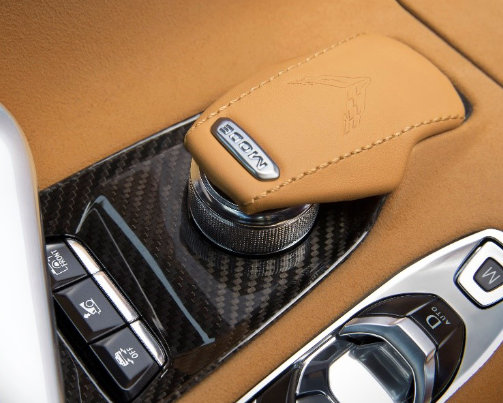
- rollover mitigation/preemptive electronic stability control
- torque vectoring by brakes
- flat tire electronic stability control enable
Electronic Parking Brake
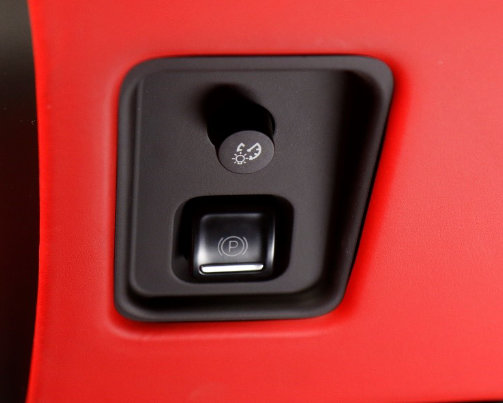
The 2020 Corvette Stingray features an electric parking brake system controlled by a switch on the left side of the instrument panel. The switch takes the place of the manual park brake foot pedal and release handle. The difference with this electric parking brake system is there are dedicated parking brake calipers.
The electronic brake control module/brake system control module diagnoses the park brake motor circuits to verify proper operation. The park brake motor circuits command actuator motor operation, which applies and releases the parking brake. The parking brake automatically releases if the vehicle is running, placed into gear, and an attempt is made to drive away. Avoid rapid acceleration when the parking brake is applied to preserve parking brake lining life.
Important: The vehicle may automatically apply the Electronic Park Brake in some situations when the vehicle is not moving. This is normal, and is done to periodically check the correct operation of the Electronic Parking Brake or due to being parked on a steep grade.
Electronic Park Brake Service
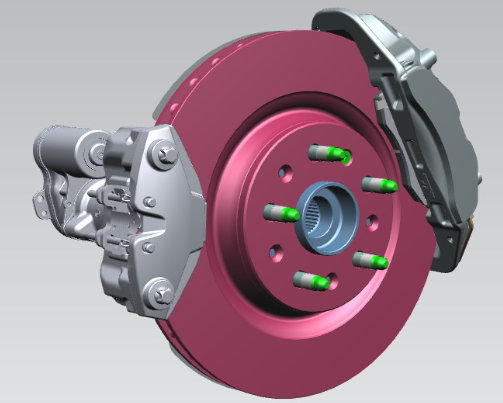
The electric parking brake system is capable of setting Diagnostic Trouble Codes (DTCs), illuminating warning lamps, and displaying messages on the driver information center.
The red braking warning lamp illuminates when the electric parking brake is applied. Additionally, the red brake warning lamp illuminates if the electric parking brake or base brake system has a concern.
If the red park brake warning lamp is flashing, the driver information center displays a SERVICE PARK BRAKE message. The red park brake warning lamp flashes when the electric parking brake is either partially applied or released, or when an electric parking brake system concern exists.
-
Engine
-
Engine Overview
The new mid-engine 2020 Corvette Stingray next-generation 6.2L (LT2) small block V8 Overhead Valve (OHV) engine, produces 369 kW (495 hp) and 637 Nm (470 lb ft) of torque when equipped with the performance exhaust. The technically advanced engine features include a dry sump oiling system, camshaft position actuator system, also known as Variable Valve Timing (VVT) and Active Fuel Management™.
Engine Specifications
- Engine Type: V8 OHV
- Displacement: 6.2L (376 CID)
- Bore x Stroke: 103.25 mm × 92 mm (4.064 in × 3.622 in)
- Block Material: Aluminum
- Cylinder Head Material: Aluminum
- Compression Ratio: 11.5:1
- Firing Order: 1-8-7-2-6-5-4-3
- Oil Type dexos™ 2 0W40 Synthetic
- Oiling System Capacity 7L Capacity (7.5 qt Capacity)
Important: The engine oil level should be checked with the engine running at operating temperature.
Engine Block
The cast aluminum engine block is a cam-in-block deep skirt 90° V-configuration with five crankshaft bearing caps. The five crankshaft bearing caps each have four vertical M10 and two horizontal M8 mounting bolts. The camshaft is supported by five camshaft bearings pressed into the block.
Crankshaft
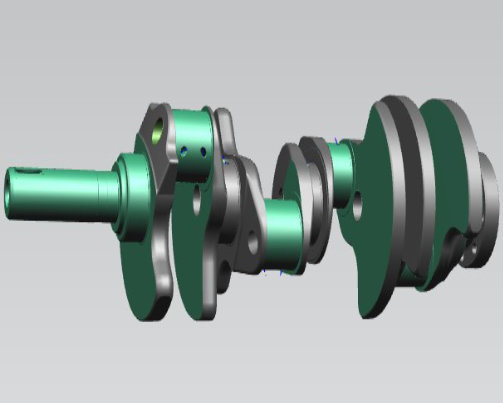
The crankshaft is made of hardened forged steel. The crankshaft is supported by five crankshaft bearings. The bearings are retained by crankshaft bearing caps that are machined with the engine block for proper alignment and clearance. The crankshaft journals are undercut and rolled. The center main journal is the thrust journal. A Crankshaft Position Sensor (CKP) reluctor ring is press-fit mounted at the rear of the crankshaft. The reluctor ring is not serviceable separately.
Pistons and Connecting Rods
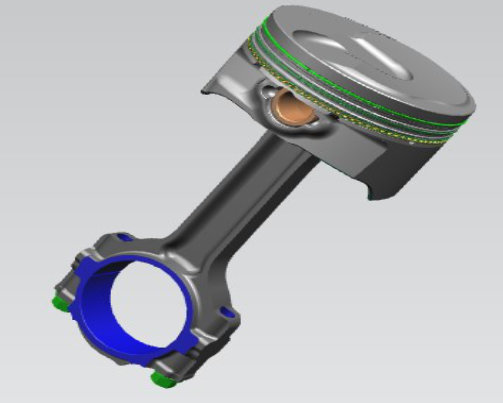
The low friction, lightweight cast aluminum pistons incorporate two compression rings and one oil control ring assembly. The piston pins are chromium steel and are a full-floating design. The powdered metal connecting rods are fractured at the connecting rod journal and then machined for the proper clearance. All applications use a piston with a graphite coating on the piston skirt.
Oil Pump Assembly
Engine lubrication pressure is supplied by a two-stage oil pump assembly that is mounted to the front of the engine block and is driven directly off the crankshaft sprocket. This oil pump assembly consists of a primary vane-type variable displacement pump and a secondary gerotor pump. The primary vane-style pump, located at the rear of the pump housing, rotates clockwise and draws oil from a pickup in the bottom of the oil tank via a transfer tube. The transfer tube connects to the oil tank outlet and passes through the engine front cover. The primary pump contains a pressure relief valve that protects the oil filter, mounted on the engine oil cooler, from over-pressurization during cold engine start up. If system pressure exceeds 600 kPa (87 PSI), the pressure relief valve opens and exhaust oil backs into the oil pan. The front or forward gear set is the secondary pump set, and it scavenges oil from the oil pan via two locations in the oil pump screen that is located at the bottom of the oil pan. Oil scavenged from the oil pan is delivered back to the oil tank via a transfer tube that passes through the engine front cover and enters the inlet at the bottom of the oil tank.
Oil Tank
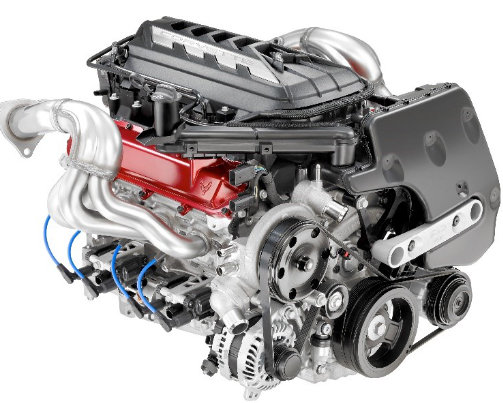
Incorporated within the oil tank assembly are the oil level indicator, oil fill cap, positive crankcase ventilation centrifugal air/oil separator, and oil pick up screen.
Piston Oil Nozzles
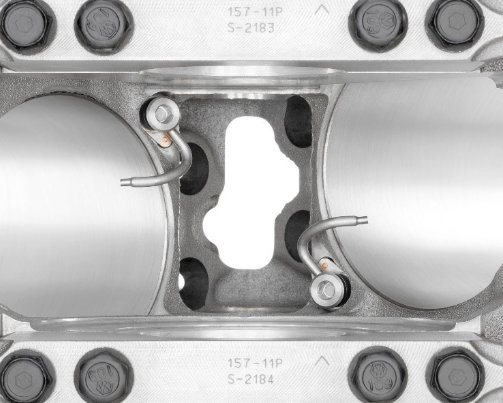
The piston oil nozzle provides oil to the bottom side of the piston for cooling purposes. The piston oil nozzles have an internal check ball that remains in the normally closed position by the spring until the system oil pressure exceeds 300 kPa (43.5 PSI).
Oil Pan
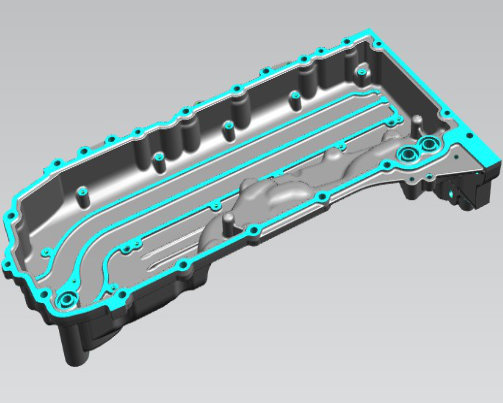
The structural cast aluminum dry-sump oil pan incorporates drain plugs, an oil pickup screen, and internal oil passages. An external oil cooler assembly mounts directly to the underside of the oil pan.
Cylinder Head
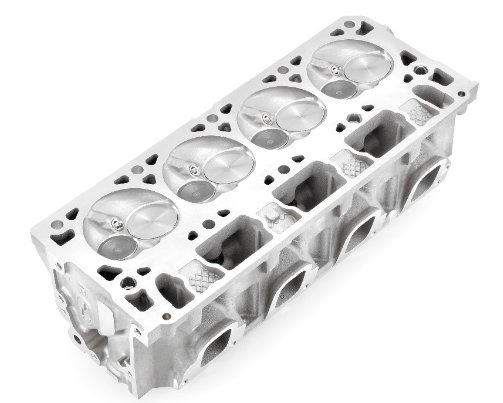
The cast aluminum cylinder heads have pressed-in-place powdered metal valve guides and valve seats. The valve rocker arm covers are retained to the cylinder head by 10 perimeter-mounted rocker arm cover bolts. Cylinder heads are a high-flow design with offset intake valve rocker arms.
Crankcase Ventilation System
Filtered fresh air is routed from upstream of the throttle plate through a formed nylon fresh air tube to a positive crankcase ventilation fitting in the left and right rocker arm cover. The rocker arm cover design shields against rocker arm oil spray, thereby reducing the potential for oil being drawn back into the fresh air positive crankcase ventilation tube during any backflow of the ventilation system. Separated vapor from the engine oil tank is routed to a positive crankcase ventilation fitting in the rocker arm covers via a formed nylon recirculation tube. Crankcase vapor is routed through a formed nylon foul air tube from a positive crankcase ventilation connection on the engine oil separator in the engine valley to right side rear of the intake manifold.
Ignition Coils
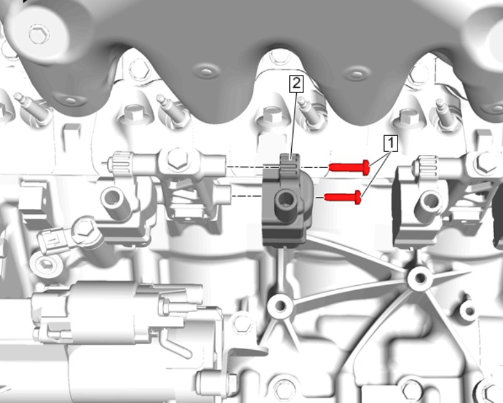
While the functionality and components of the ignition system are the same on the 6.2L (LT2) engine, the ignition coils have moved from the top of the valve cover to the side of the engine block.
Fuel Injectors
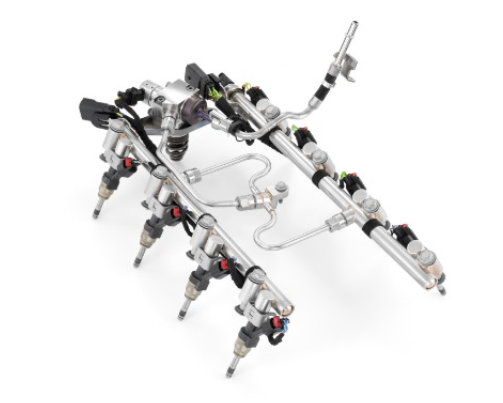
Fuel injectors provide high fuel pressure directly to the cylinders. The fuel injectors mount in the cylinder head and require more electrical power due to the high pressure needed. The ECM energizes each fuel injector by supplying 65 volts to open the injector and then uses 12 volts to hold the injector open. Injectors have six precision machined holes to generate a cone-shaped oval spray pattern.
High Pressure Fuel Pump
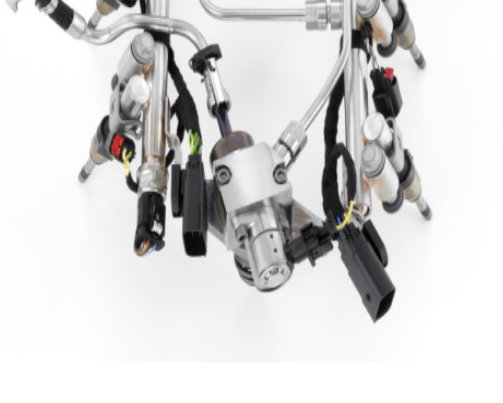
The high pressure fuel pump supplies the necessary high fuel pressure for direct injection and regulates the fuel pressure with an actuator. To keep the engine operating correctly, the ECM requests a fuel pressure increase or decrease, depending on the engine speed and load.
The high pressure fuel pump is located at the rear of the engine and is driven by a three-lobe cam on the camshaft. A relief valve prevents excessive pressure if a failure condition is present.
Active Fuel Management™
The 6.2L V8 (LT2) features updates to the Active Fuel Management™ system. On previous model years, the components included the ECM, the valve lifter oil manifold assembly, and the Active Fuel Management™ lifters. The new Active Fuel Management™ system eliminates the need for the valve lifter oil manifold assembly. Instead, four ECM-controlled valve lifter oil solenoid valves located in the engine valley supply oil flow to the Active Fuel Management™ lifters when energized by the ECM. On this engine, the Active Fuel Management™ cylinders are 2, 3, 5, and 8.
Valve Lifter Oil Solenoid Valves
The valve lifter oil solenoid valves are electro-hydraulic actuator devices and mount to the top of the engine valley, below the intake manifold assembly. All four solenoids connect to a high control driver, internal to the ECM. The ground or control circuit for each solenoid connects to a low side driver internal to the ECM. When the ECM energizes the solenoid coil windings, the solenoid valves open, redirecting engine oil into eight separate vertical passages in the engine lifter valley and to the lifters.
Active Exhaust System
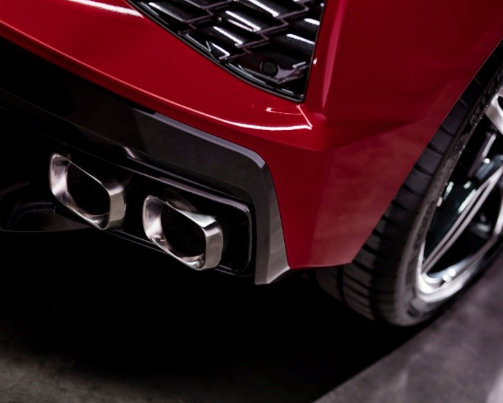
The exhaust tailpipe flow control system changes the exhaust sound for a more aggressive sound. This vehicle is equipped with two tailpipe exhaust valves installed in the low restriction exhaust path of a dual outlet muffler, near the exhaust tip on each side of the vehicle.
When a tailpipe exhaust valve is open, the low restriction exhaust path is opened to the atmosphere and the exhaust sound becomes more aggressive.
To provide a more aggressive exhaust note during vehicle starting, the exhaust tailpipe valves are open during an engine crank event during specific modes of operation, if equipped with the Z51 option. Once the engine is running, accelerator pedal position, transmission gear, and engine speed are used to determine the commanded state (open or closed) of the exhaust tailpipe valves.
Note: An exhaust tone change due to the Active Fuel Management™ system activation or during certain driving conditions may be noticed. These are necessary to meet federal noise pass-by regulations.
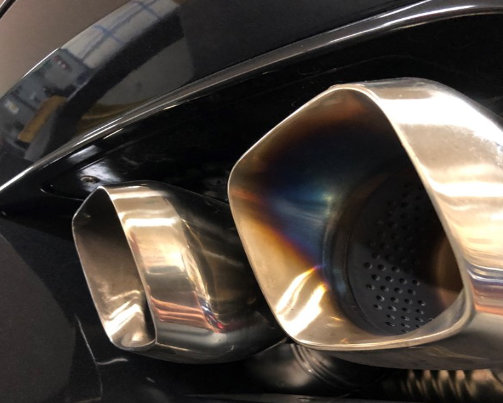
Important: Customers that choose to track their vehicle should expect the exhaust tips may turn blue due to the exhaust temperatures. The heat changes the color of the stainless steel and the bluing cannot be removed. This is a normal condition. Mufflers should not be replaced under warranty. This is not a defect in materials.
-
Transmission
-
Overview
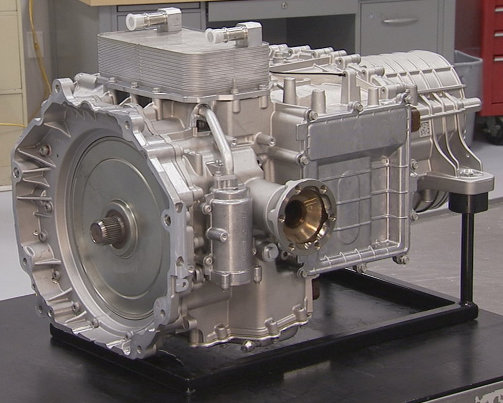
The 2020 Chevrolet Corvette has the new Tremec DCT TR 9080 8-speed transaxle. This transaxle incorporates a wet dual-clutch assembly, gear train assembly, and limited slip rear differential. This 8-speed transaxle is designed exclusively for the Corvette and provides lightning-fast shifts.
Transmission Fluid
The DCT transmission requires a special transmission fluid. Do not use any other type of fluid. The part number for the fluid is 19418016 (Canada, same P/N).
Transmission Canister Filter
There is an external oil filter located on the left side of the transmission. This filter has its own maintenance schedule. Please refer to the maintenance schedule for proper required service intervals.
Transmission Identification
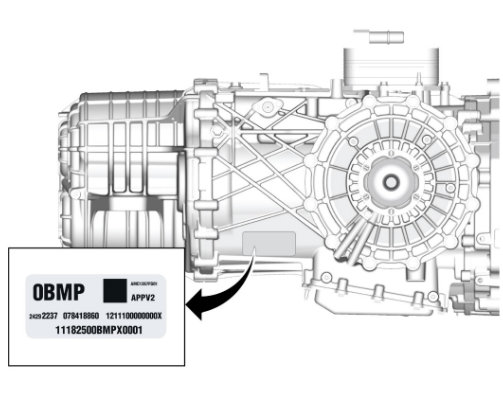
The transmission identification label is affixed to the right hand side of the transmission. It has important transmission information, including the part number, build information, and the Transmission Unique Number needed for programming.
TR9080 MHS 8-Speed Dual Clutch Automatic Transaxle
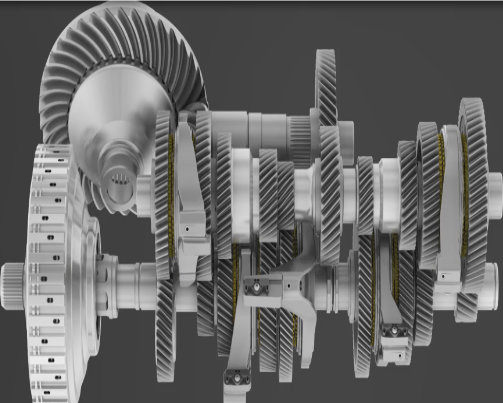
The TR-9080 8-speed dual clutch transaxle combines the functionality of an automated transmission, a wet clutch, the differential, an electronic limited slip differential, park system, and connectors in one transmission. The clutch system features concentric clutches that are normally open with spring force. Closing action occurs from hydraulic pressure acting against rotating pistons. When the hydraulic pressure increases, the piston will apply and hold the desired clutch plates, which provide input to one of the two input shafts. The main control solenoid valve body, located in the bottom pan, controls and maintains clutch pressure.
The TR-9080 32-bit transaxle control module controls all functions of the gearbox, including the hydraulic power system, the two clutches, the eight forward gears and reverse, and the park lock system.
Transaxle Operational Characteristics
In Tour mode, the transaxle sensors are continuously monitoring driver actions, anticipating driver requests, and providing a premium and smooth driving experience. When driving in Sport or Track mode, shift maps and shift feels are more aggressive and faster.
You may also hear the shift forks when shifting out of PARK. This may be more noticeable when parked on a hill without setting the parking brake. A slight delay may occur when shifting out of PARK during extremely cold weather. This may occur because the ambient temperature causes reduced fluid viscosity, which means it takes the fluid longer to circulate.
Creep and low speed maneuvers may feel slightly different because the transaxle does not have a torque convertor. In this scenario, the clutches and brakes work together to control low speed propulsion or creep.
Important: While in Sport, Track, My Mode or Z Mode driver modes, the transmission may downshift with the engine RPMS staying higher. This is just like the C7 "Performance Shift Active" mode. The 2020 Corvette will not display the "Performance Shift Active" message in the DIC.
Electronic Transmission Range Select System
When a gear is selected, the transmission shifts into the range commanded by the Electronic Transmission Range Select (ETRS) system. The gear shift control module in the ETRS system has no mechanical linkage to the transmission. Instead, the gear shift control module provides the proper gear selection based on input from the Engine Control Module (ECM). The backup park lock functionality is internal to the transmission and can force the transmission into the PARK position under specified conditions.
Manually Placing the Transaxle into Neutral
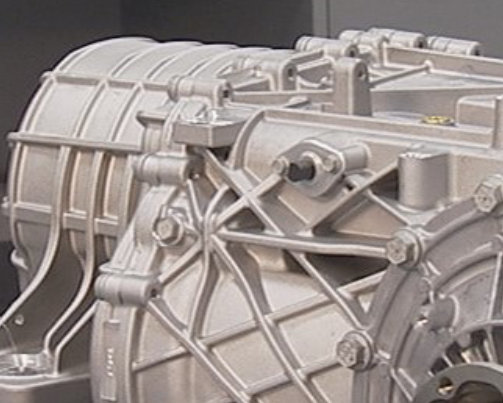
With the ETRS system, the transmission parking pawl cannot be disengaged unless the engine is running. The manual park release can be used if there is a loss of power and the vehicle needs to be moved. Only GM dealers will have access to the manual park release tool. Due to spring pressure, the tool must be applied to the release lever and held in the release position while moving the vehicle. The manual park release is located on the right side of the transmission and can be accessed through the trunk.
Transmission Cooler
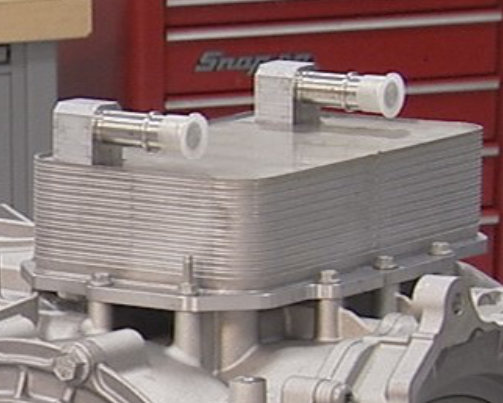
A transmission cooler mounts on top of the transmission. Engine coolant runs through the cooler to lower the transmission fluid temperature. The cooler has an internal bypass to help the transmission reach operating temperature. The cooler bypass is a pressure-based logic bypass that allows cold, viscous fluid to avoid both the heat exchanger and pressure filter.
Please note there is no fluid flush procedure required; do not flush this transmission.
Limited Slip Differentials
A limited slip differential is a spiral bevel or curved and oblique design, having two or more teeth of the ring and pinion gears in contact all times. Additionally, the pinion gear is located on the center/side of the ring gear instead of in contact with the ring gear at the bottom. This transaxle design also allows the use a single fluid, oil cooler, pump, oil sump, and filtration system for both systems. The force-cooled, electro-hydraulically controlled limited slip differential is integrated into the transmission control system to allow fast responsiveness and fine control of the hydraulic limited slip system. Both the manual limited slip differential and electronic limited slip differential provide responsiveness and accurate operation.
-
HVAC
-
Heating and A/C Overview
The Chevrolet Corvette features a dual zone automatic climate control system to regulate temperature inside the passenger compartment. It also transfers undesirable heat and moisture from inside the vehicle cabin to the outside air. Additionally, the Heating, Ventilation, and Air Conditioning (HVAC) system contains a passenger compartment air filter.
Dual Zone Automatic Climate Control
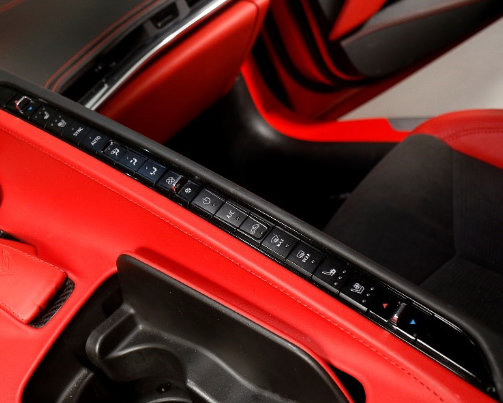
The dual zone climate control system allows the driver and front passenger to individually control the temperature, air delivery mode, and fan control on their side of the vehicle. The driver and front passenger may select either automatic operation or individual control settings using the front HVAC control panel in the center stack or by using the HVAC controls on the infotainment touch screen, if equipped.
Pressing the automatic operation (AUTO) control on the HVAC control panel or infotainment touch screen, if equipped, enables AUTO mode for both the driver zone and the front passenger zone.
The individual temperature for each zone may be set using the HVAC blower controls or the temperature control dials on the center stack. Temperatures between the driver and the front passenger zones may be synchronized using the synchronized temperature (SYNC) control on the HVAC control panel or infotainment touch screen.
Climate Control Operation
The Body Control Module (BCM) is a Controller Area Network (CAN) device that interfaces between the operator and the HVAC system. The BCM controls desired air temperature and air distribution settings. The BCM, which acts as the vehicle Power Mode Master (PMM), provides a device ON signal for the HVAC controls.
Passenger Compartment Air Filter
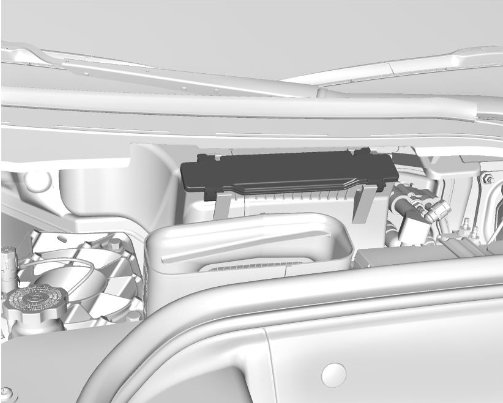
The passenger compartment air filter removes dust and other irritants from the air before it enters the cabin. The passenger compartment air filter is located under the hood between the battery and windshield.
The recommended filter change interval is every two years or 57,900 km (36,000 mi). If there is a reduction in airflow or window fogging, inspect the filter. Vehicles driven in environments with poor air quality or high dust levels may require more frequent service.
Heated and Vented Seats
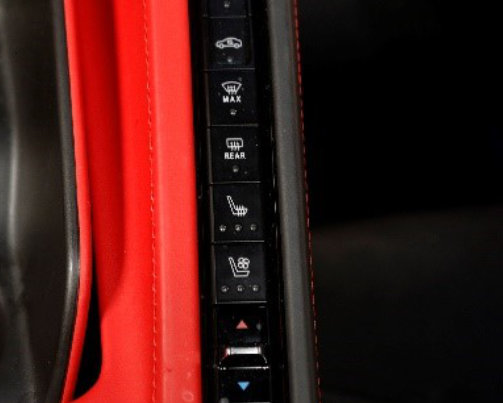
Separate heated and vented seat switches located on the HVAC control head control the temperature of the front heated seats. The BCM is the system master and monitors the seat switch activations to determine the requested operating mode. The BCM sends a Local Interconnect Network (LIN) bus serial data message to the front seat heater control module, actuating the self-regulated heating pads or ventilation motors. Additionally, the BCM controls the indicators to provide system status to the operator. With each press of the switch, the system will cycle through High, Medium, Low, and then back to OFF again.
Each vented seat consists of two blower motors: one in the seat back and one in the seat cushion. During vented seat operation, the vented seat blower motors move cabin air through channels in the foam pad and small holes in the seat covers, causing a cooling sensation.
-
Body Systems
-
Overview
The 2020 Chevrolet Corvette Stingray body systems provide the driver and passenger with latest safety and convenience features including various interior and exterior lighting controls, lockout switches and headlamp leveling.
Power Windows
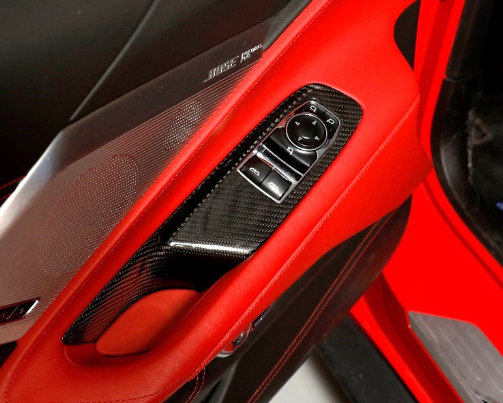
The driver and passenger doors contain smart window motors that detect excessive resistance while performing the express up function. The motor automatically reverses direction to prevent damage or injury to anything trapped between the door frame and the window as it closes. This feature can be overridden by holding the window switch in the closed position.
Rear Camera Mirror
The rear camera mirror features an inside rear view mirror that can be used as a standard reflective mirror or a high resolution (1280×240 pixel) display for the vehicle’s high definition camera.
Preference controls include On/Off, Brightness, Zoom, and Tilt.

The system includes a high-resolution, digital, roof shark-fin mounted camera connected to the outside rear view camera via a shielded coaxial cable.
When the video monitor is turned off, the mirror acts like a standard reflective mirror with auto dimming features. When the video monitor is turned on, it provides an unobstructed view behind the vehicle with a field of view approximately 300% wider than a traditional mirror.
Power Door Locks
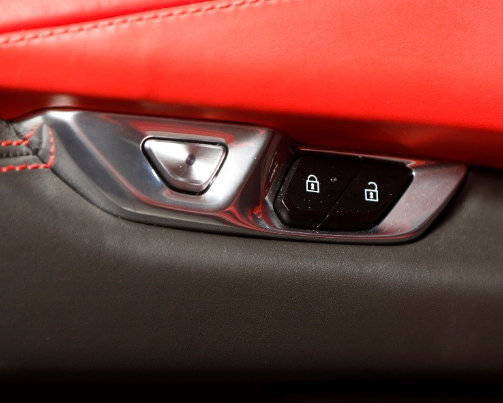
When a door lock switch is activated, the BCM supplies battery voltage to the door lock actuator lock or unlock control circuits. Because the opposite side of the lock actuator connects to ground, the doors and fuel filler door lock or unlock as commanded.
Headlamps
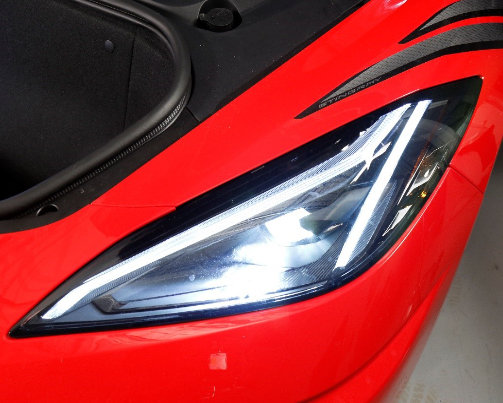
The headlamps on the 2020 Corvette Stingray consist of multiple Light Emitting Diodes (LEDs), which provide high and low beams. The headlamp assembly also contains a parking lamp located at the top of the housing. The turn signals/Daytime Running Lamps (DRLs) are located on the outer edge of the headlamp assembly.
-
Driver Information and Entertainment
-
Overview
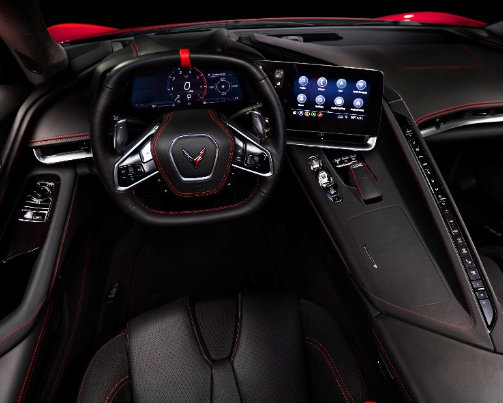
The Chevrolet Corvette offers a variety of different driver information and entertainment features. The standard instrument panel includes an array of gauges. A head-up display projects Information onto the windshield that is viewable from the driver’s seat.
Infotainment Controls and Display
The infotainment display and controls are a separate component from the radio, combined into an assembly. The assembly contains the control knobs and buttons for all audio and HVAC functions and the information display. The assembly is supplied battery voltage and ground from the vehicle harness.
Control information, touch communications and dimming level for the display are communicated via a LIN serial data circuit to the Radio.
The information display provides a feedback on the touch screen and certain controls.
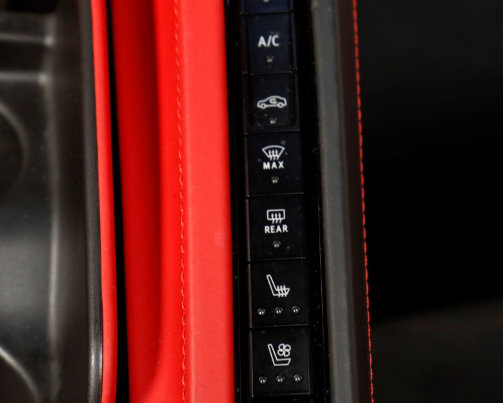
HVAC data for controls and status indicators is communicated between the HVAC controls and the HVAC control module with a separate LIN serial data circuit. HVAC status screen information from the HVAC control module is transmitted to the radio on the GMLAN serial data circuit.
Steering Wheel Controls
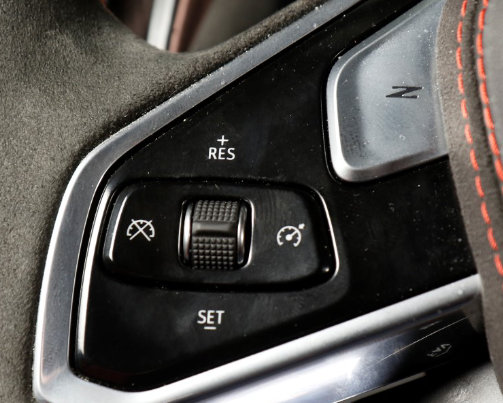
The steering wheel control switches are a redundant function of the primary controls of the associated component.
The steering wheel controls are divided into a right-hand set and left-hand set. The controls on the right side of the steering wheel control the audio system, the instrument panel, and the driver information center. The right-hand switch controller consists of LEFT/RIGHT directional buttons and a center Select/Scroll switch. Additionally, the volume buttons are located on the right-hand switch controller as well.
The left-hand controls are for cruise control, Z Mode and radio preset stations.
Multi-Band Antenna
The multi-band antenna is located on the roof of the vehicle. This type of antenna may be used with the AM/FM radio, but is primarily for cellular, GPS signals, and XM, if the vehicle has these features. Keep this antenna clear of snow and ice for clear reception. Loading items onto the roof of the vehicle can interfere with the performance of the system, ensure the multi-band antenna is not obstructed.
Diversity Antenna
The diversity antenna system uses antennas applied as appliqués to the rear glass and two antenna amplifiers. The right antenna 1 receives both AM and FM signals, while the left antenna 2 may receive FM and DAB signals only. The antenna amplifier receives the signals from the glass antenna. Each antenna amplifier is connected to the radio by a coaxial cable.
The radio antenna amplifier is enabled when the radio is turned on. The radio provides battery voltage to the antenna amplifier using the center conductor of the antenna coaxial cable. When a 12 V signal is seen by the amplifier on the center conductor of the antenna coax, the received signals are amplified.
When the AM band is selected on the radio, the antenna 1 amplifier connects the AM antenna to the radio. When the FM band is selected, both antenna amplifiers provide FM signals to the radio. The radio switches between the two FM antennas, monitoring the signal strength and combines the signals to create one stronger signal.
Global Positioning System (GPS) Antenna
The global positioning system (GPS) antenna is part of the multi-band antenna located on the roof of the vehicle. The GPS antenna is used to collect the signals of the orbiting GPS satellites. Within the antenna is housed a low noise amplifier that allows for a more broad and precise reception of this data. The GPS antenna amplifier is powered through the coaxial cable.
The GPS antenna is connected to the telematics communication interface control module via a coax cable. The GPS signal is sent to the navigation radio via an Ethernet harness.
External WiFi Antenna
On some system configurations, an external WiFi antenna is connected to the radio to support longer range reception, compared to the internal WiFi antenna. Over-the-air updates is the main feature supported by this antenna. Data transfers used for consumer media will also be supported by this antenna when connected to a local network. The antenna is connected to the radio via coaxial cable.
Teen Driver
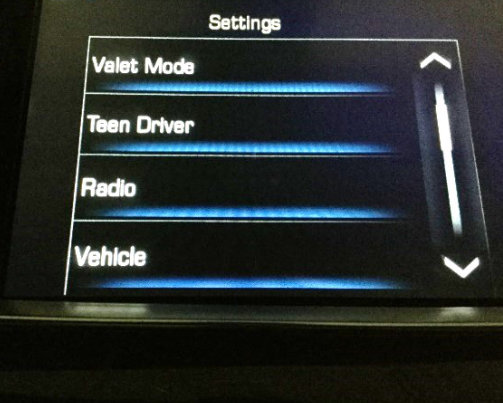
Teen Driver allows multiple keys to be registered for beginner drivers to encourage safe driving habits. When the vehicle is started with a Teen Driver key, it will automatically activate certain safety systems, allow parental setting of some vehicle features, and limit the use of others. The Teen Driver feature puts the vehicle in a mode that can only be unlocked with a valid pin. The Report Card will record vehicle data about driving behavior that can be viewed later. When the vehicle is started with a registered key, the driver information center displays a message that Teen Driver is active.
Valet Mode
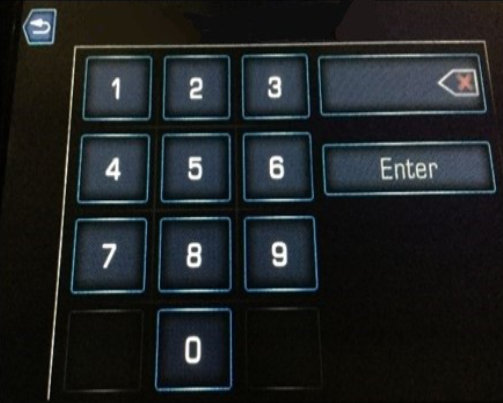
If equipped, valet mode can be enabled through the infotainment system settings menu. The customer will be prompted to create and enter a 4-digit code to enable and disable this feature. When valet mode is enabled, the infotainment system, steering wheel controls, and some other features (depending on vehicle equipment), will be locked out.
If the user forgets the four-digit code, it can be sent via Bluetooth to the currently paired phone or the scan tool can clear the valet mode code.
Head-Up Display
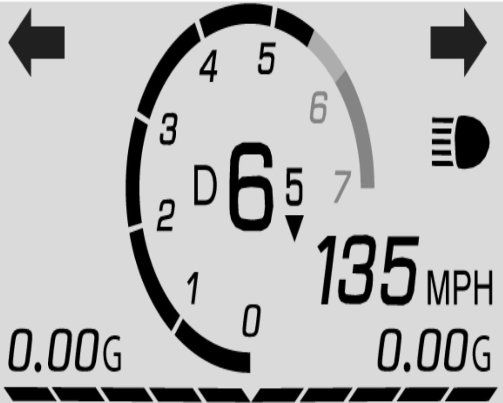
The Head-Up Display projects a color image onto the windshield that is viewed from the driver seat. Information that is relevant to the driver is displayed.
The instrument panel cluster sends the image information to the Head-Up Display via a discrete video cable. The image sent to the Head-Up Display is closely related to the information concurrently being displayed on the instrument panel cluster or driver information center.
The Head-Up Display switch located to the left of the steering wheel controls the display based on driver inputs. The Head-Up Display provides the switch with a low reference and monitors a signal circuit. The head-up display switch is made up of a resistor ladder and three switches: Up / Down HUD, INFO, and + / - brightness.
Vehicle Performance Data Recorder
The Performance Data Recorder is a secondary display system that displays and records video, audio, and vehicle data. This data is stored on a secure digital (SD) memory card. The system is operated through the radio display touch screen and can display several combinations of vehicle information.
In Track Mode, the Performance Data Recorder overlays the maximum level of data onto a drive video, including vehicle speed, engine speed, turn signal indicators, high beam indicators, and transmission gear displays. In addition, the lateral and longitudinal G-Forces are displayed as a dot within a bubble and active handling active indicator only displays if it is active.
-
Safety and Security
-
Overview

The 2020 Chevrolet Corvette Stingray offers a comprehensive suite of driver assistance and safety technologies. Ultrasonic sensors measure the position of objects close to the vehicle. Long-range and short-range radar sensors monitor the vehicle’s surroundings. An active safety control module analyzes sensor input, and can help enhance driver awareness to potential crash threats, allowing the driver to react and make changes to avoid them.
Supplemental Inflatable Restraint System
During a collision, the restraints control module determines the severity of the crash using data collected from impact sensors. The restraints control module processes the information provided by the sensors to determine the safest combination of air bag and pretensioner deployment. If the force of the impact is not sufficient to warrant air bag deployment, the restraints control module may still deploy the seat belt pretensioners.
Side Blind Zone and Rear Cross Traffic Alert
Side blind zone alert is intended to assist drivers when changing lanes. The system uses short-range rear side radar sensor modules to detect objects alongside the vehicle in an area approximately:
- 0.5 to 2.0 m (1.5 to 6.0 ft) off the ground
- 3.5 m (11 ft) from the side of the vehicle
- 5 m (16 ft) behind the mid-point of the vehicle
When the system detects a vehicle in the side blind zone while driving forward, an amber warning symbol will light up in the appropriate outside mirror. This indicates that it may be unsafe to change lanes. If the driver then activates the turn signal, the amber warning symbol starts flashing as an extra warning not to change lanes. Drivers can disable lane change alert in the vehicle personalization menu under collision/detection systems.
Rear Parking Assist Operation
When a driver is reversing below speeds of about 11 km/h (7 mph), the B306 parking assist alarm sensors may detect objects behind the vehicle up to 1.8 m (6 ft). When an object is within 0.6 m (2 ft) of the rear bumper, five repeating low-pitched beeps are played from the rear speakers, followed by a continuous tone. Some vehicles may have a park assist display on the P16 instrument panel cluster module with bars that show distance to object, driving direction, and object location information for the parking assist system. As the vehicle gets closer to the detected object, distance-to-object information and caution triangles will change from yellow, to amber, to red. The parking assist system can be turned on and off using the parking assist switch.
-
Chassis
-
Overview
The 2020 Chevrolet Corvette has an all-new body structure, which is more than 10% stiffer than the previous generation. The rigid body structure firmly resists twisting forces and provides a solid foundation for the front and rear frames and the four-wheel independent suspension system. This firm structure contributes to the improved ride and handling characteristics of the vehicle. The 2020 Chevrolet Corvette is available with an electronic suspension control system.
Note: Corner weight adjustments can be made at the spring seat on Z51 (FE3 or FE4).
Front and Rear Frame Structure
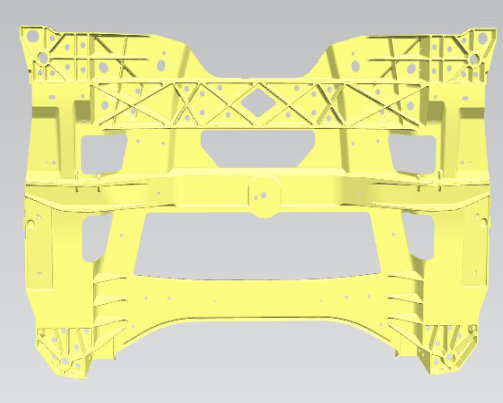
A variety of underbody components contribute directly to the overall handling performance of the Chevrolet Corvette. The front and rear frames are an integral part of the unibody structure and are made of hollow cast aluminum, which reduces the weight of the vehicle.
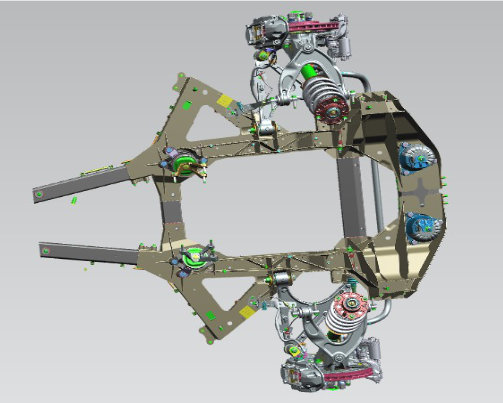
The rear frame, which attaches to the body rail through rubber insulators, is the foundation for the rear suspension components and the rear axle.
Collision Repair
GM is taking steps to ensure that structural repairs of this vehicle are completed by capable repairers with the proper training, tools and equipment. Collision repair centers that are on either the GM Collision Repair Network (CRN) or the Cadillac Aluminum Repair Network (CARN) will be the only shops permitted to receive the restricted structural part numbers from a GM dealer. The majority of the structural frame components for the C8 Corvette will be put on parts restriction.
GM dealers with body shops that want to become part of the GM Collision Repair Network can start the process by using the enrollment link at:
https://www.genuinegmparts.com/for-professionals/general-motors-collision-repair-network
The GM Collision Repair Network incorporates performance measurements on pre- and post-repair scans, usage of OEM repair procedures, completion of re-calibrations and quality-control checks.
For more Collision Center Information and Frame restricted parts refer to Global Connect Message — GCUS-9-8993 (U.S.). In Canada, further information will be published in a forthcoming Global Connect message.
Front Suspension
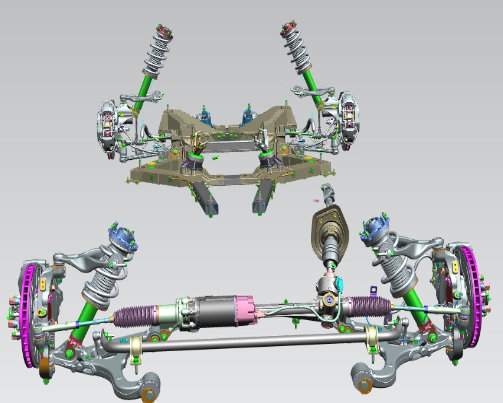
The front suspension is a short/long arm design with double wishbone-type control arms. The upper control arm is forged aluminum and the lower control arm is cast aluminum. A stabilizer bar is connects the lower control arms.
The shocks are a monotube design, which contain the shocks’ components within one tube. A floating piston separates the shock oil and the shock gas, preventing shock oil aeration.
Magnetic Selective Ride Control 4.0 is available with the Z51 option package. Additionally, an adjustable front lift system with memory is available to lift the front of the car when entering steep driveways or other road disturbances.
Rear Suspension
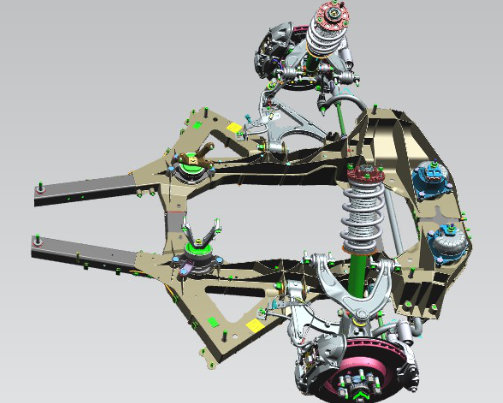
The rear suspension also incorporates short/long arm design with double wishbone type control arms. Additionally, there are monotube shock absorbers and a rear stabilizer bar to control body roll.
Electronic Suspension Control
The electronic suspension control system utilizes the latest generation in magnetorheological technology to control each of the shock absorbers and struts independently. Magnetorheological technology independently controls the fluid viscosity in each strut and shock absorber. Front struts and rear shock absorbers contain an internal electromagnet coil and have micron-size metal particles in the magnetorheological fluid.
The suspension control module applies Pulse Width Modulated (PWM) current to the electromagnet coil within each strut or shock. The PWM current increases the fluid viscosity by aligning the metal particles within it, which increases or decreases the suspension damping force during both compression and rebound.
Driver Mode Control
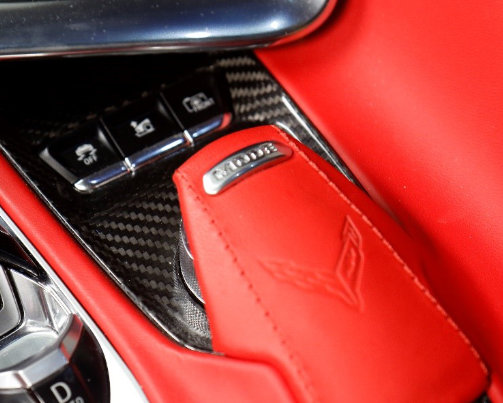
Driver mode control adds a sportier feel, provides a more comfortable ride, or assists in different weather and road conditions. This system simultaneously changes the software settings of various sub-systems to optimize driving performance. Depending on the option package, available features, and mode selection, the exhaust, suspension, steering, brakes, and powertrain change settings to achieve the desired mode vehicle characteristics.
Weather, Tour, Sport, and Track modes have preset vehicle settings for use in different driving conditions. My Mode and Z-Mode can be customized by the driver. In these two modes, vehicle settings are configured to enhance and personalize the driving experience.
To activate My Mode, Weather, Tour, Sport, and Track Mode, turn the driver mode control knob on the center console to make a mode selection. When a mode is selected, a unique indicator consistently displays in the driver information center.
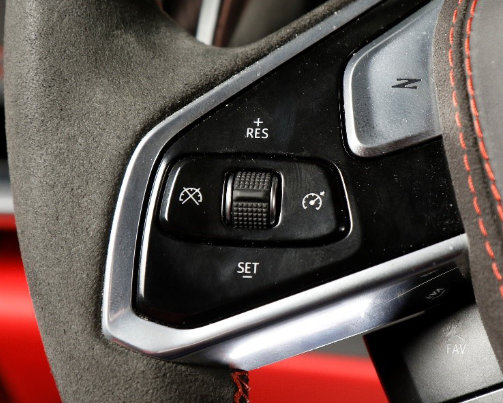
To activate Z-Mode, press the Z-Mode button on the steering wheel. To deactivate, the driver can either select a different mode through the Driver Mode Control knob or press the Z-Mode button on the steering wheel. When Z-Mode is de-activated through the Z-Mode button, driver mode control is always set back to Tour Mode.
Driver Modes and DescriptionsWeather
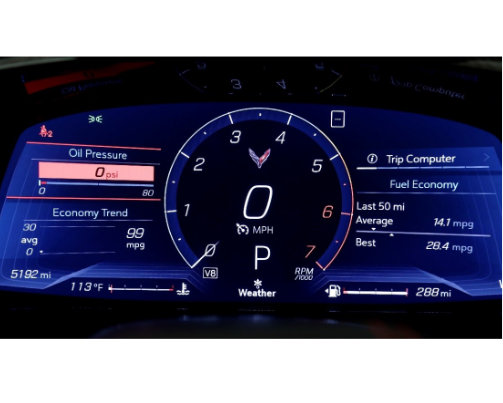
Weather mode is used for slippery surfaces to help control wheel speed. This can compromise the acceleration on dry asphalt. This feature is not intended for use when the vehicle is already stuck in sand, mud, ice, snow, or gravel.
Tour
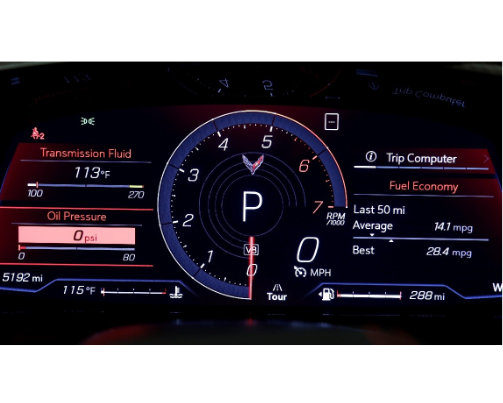
Tour mode is used for normal city and highway driving to provide a smooth, soft ride. This setting provides a balanced setting between comfort and handling. This is the standard mode.
Sport
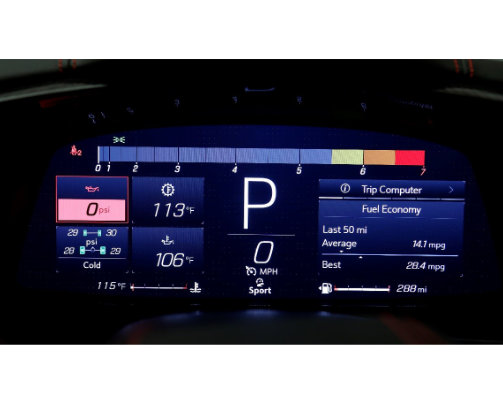
Sport mode is used when road conditions or personal preference demand a more controlled response for spirited driving. In this mode, the vehicle monitors driving behaviors and automatically enables performance shift features when spirited driving is detected. These features maintain lower transmission gears to increase available engine braking and improve acceleration response. The vehicle exits this feature and returns to normal operation after a short period when no spirited driving is detected.
Track
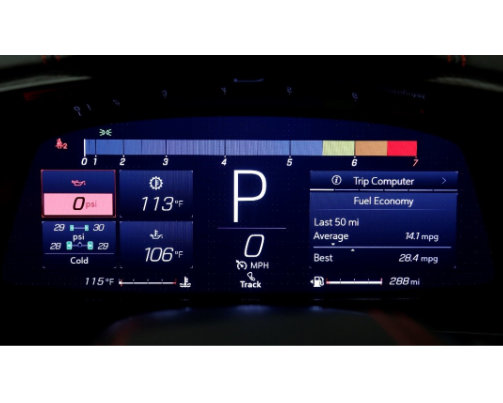
Track mode is used for closed race tracks. Use when maximum vehicle handling is desired. When in Track mode, the dual clutch transmission and steering will function similarly to Sport mode. The accelerator pedal is adjusted to give maximum control during the highest level of spirited driving.
My Mode
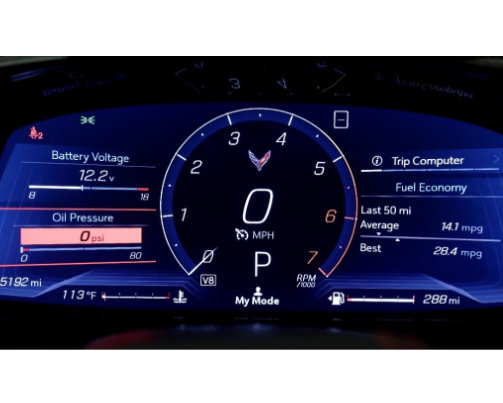
My Mode is used to personalize everyday driving. This mode is designed to allow the driver to configure vehicle sub-systems to their own preference for city or normal driving. Through the center display, the following vehicle sub-systems may be available for customization in this mode.
- Engine Sound: (some choices, if equipped) Tour, Sport, Track
- Steering: Tour, Sport, Track
- Suspension: (some choices, if equipped), Tour, Sport, Track
- Brake Response: Tour, Sport, Track
Z-Mode
Z-Mode is used to personalize dynamic driving. This mode allows the driver to configure vehicle sub-systems to their own preference for maximum handling. Z-Mode further enhances the driver’s experience by adding a powertrain customization. Through the center display, the following vehicle sub-systems may be available for customization in this mode.
- Engine Sound: (some choices, if equipped) Stealth, Tour, Sport, Track
- Steering: Tour, Sport, Track
- Suspension: if equipped, Tour, Sport, Track
- Powertrain: Normal, Sport, Track, Weather
- Brake Response: Tour, Sport, Track
Front Suspension Leveling System
The front suspension leveling system raises the front of the vehicle approximately 35 mm (1.4 in) in less than 3 seconds when the vehicle is traveling less than 40 km/h (25 MPH) during low-speed driving scenarios to help avoid objects on the ground. Additionally, this helps the vehicle transition onto inclined driveways and drive over bumps in the road that exceed available front spoiler ground clearance. This reduces the potential for damage to the vehicle.
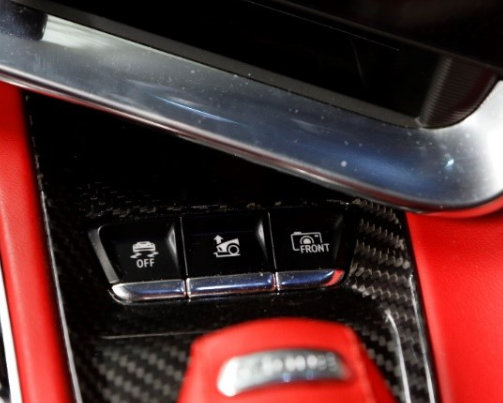
The driver can manually raise or lower the vehicle by the Lift/Lower Select button located on the S86 vehicle stability control system switch. When pressing the button, the vehicle begins to raise or lower ("level"), depending on the current ride height position. The driver also has the ability to save GPS locations, which automatically raises the front of the vehicle upon returning to that location. Upon leaving a saved GPS location, the front of the vehicle automatically lowers. The driver also has the ability to delete a previously saved or undo previously saved or deleted GPS locations.
Wheel and Tire Features
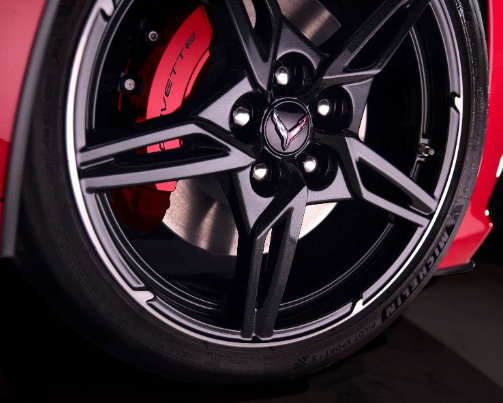
The 2020 Corvette has the following wheel and tire dimensions:
Wheel Size:
Front: 19 in × 8.5 in (w/ 5×120 mm) bolt pattern
Rear: 20 in × 11 in (w/ 5×120 mm bolt pattern)
Tire Type and Size:
Stingray: Michelin Pilot Sport ALS
Stingray with Z51: Michelin Pilot Sport 4S
Front: 245/35ZR19
Rear: 305/30ZR20
-
Steering
-
Overview
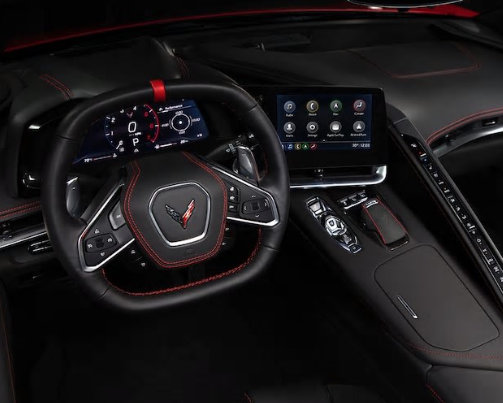
The steering wheel controls are a direct input to the Body Control Module (BCM). The adaptive cruise controls, steering wheel heater control, and OnStar® steering wheel controls are located on the left side of the steering wheel. The controls on the right side of the steering wheel control the audio system, the instrument panel, the Z-mode button, and the driver information center.
Steering Wheel and Controls
The steering wheel on the 2020 Corvette has a race-inspired shape and may include a red stripe at the twelve o’clock position to provide the driver visual indication of the straight ahead position during competitive driving.
Heated Steering Wheel
The heated steering wheel system consists of a heated steering wheel, a heated steering wheel switch, and a steering wheel heat module. The heated steering wheel includes non-serviceable heating elements and a temperature sensor located in the left and right sides of the steering wheel rim. The steering wheel heat control module is located at the bottom of the steering wheel center hub.
When the heated steering wheel switch is pressed, the switch signal circuit is grounded and the steering wheel heat module turns on the heated steering wheel. The system then remains on until the customer turns it off. The normal operating temperature, 32°C (89.6°F), is achieved in approximately three to four minutes. The built-in temperature sensor provides input to the controller to control temperature. The heated steering wheel will not operate if the vehicle temperature is at or above 32°C (89.6°F).
Belt-Driven Electric Power Steering System
The 2020 Chevrolet Corvette Stingray features a belt-driven electric power steering system consisting of the following components:
- Steering Gear
- Drive Belt and Power Steering Motor
- Power Steering Control Module
- Torque Sensor
Steering Gear
The power steering control module and motor attach to the base of the steering gear housing. The module and motor apply power assist through the drive belt and ball nut mechanism to the steering gear.
Drive Belt and Power Steering Motor
The belt-driven electric power assist steering system reduces the amount of effort needed to steer the vehicle. The power steering control module and motor attach to the base of the steering gear housing. The motor applies power assist through the drive belt and a ball nut mechanism. The ball nut mechanism translates the rotational movement of the drive belt into lateral movement of the steering gear.
Power Steering Control Module
To determine the level of motor assist, the power steering control module uses input from the torque sensor, motor rotational sensor, battery voltage circuit, and Controller Area Network (CAN) serial data circuit. Vehicle and engine speed information from the CAN serial data circuit are also used to adjust the amount of steering assist needed to steer the vehicle. At low speeds, more assist provides for easy turning during parking maneuvers. At higher speeds, less assist provides for improved road feel and directional stability.
Torque Sensor
The torque sensor attaches to the steering gear housing, near the input shaft of the rack and pinion steering gear. It communicates the driver’s steering intent to the electric power steering module. The electric power steering module uses torque sensor information to determine the level of assist provided by the electric power steering motor. It attaches to the power steering motor via the torque sensor wiring harness connector.
-
Training Courses
-
Training Courses — Description and Number Description
Course Name and Number
Emerging Issues Corvette Overview (U.S)
10220.02V
2020 Chevrolet Corvette Stingray Introduction (U.S)
B10YY.L20W1
2020 Chevrolet Corvette Stingray Technical Assessment (U.S)
B10YY.L20W2
2020 Chevrolet Corvette New Model Launch Course Announcement (U.S and Canada)
10320.89W
-
New Special Tools for Corvette
-
Part Number
Description
CH-45400-100
Strut Compressor Adapter
CH-47960-15
Alignment Adapter Mounting Pins
DT-52089
Wiring Harness Connector Remover
DT-52388
Manual Park Release Wrench
DT-52660
Transmission Support/Service Fixture
DT-52724
Input Seal Installer
DT-52725
Axle Seal Installer (L & R)
DT-52796
Guide Pins, Control Module Installation
EN-52055-200
Support Mount, Transmission (lift table)
J-44748
Input Shaft Seal Remover
EN-51007-100
Engine Support Fixture Adapter
EN-52499
Engine Support Bolts
EN-52751
Flywheel Holding Tool
-
Version Information
-
Version
1
Modified
Released March 06, 2020